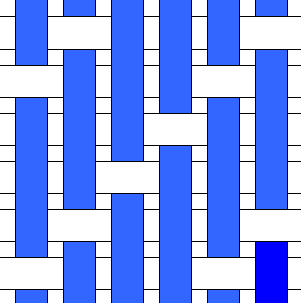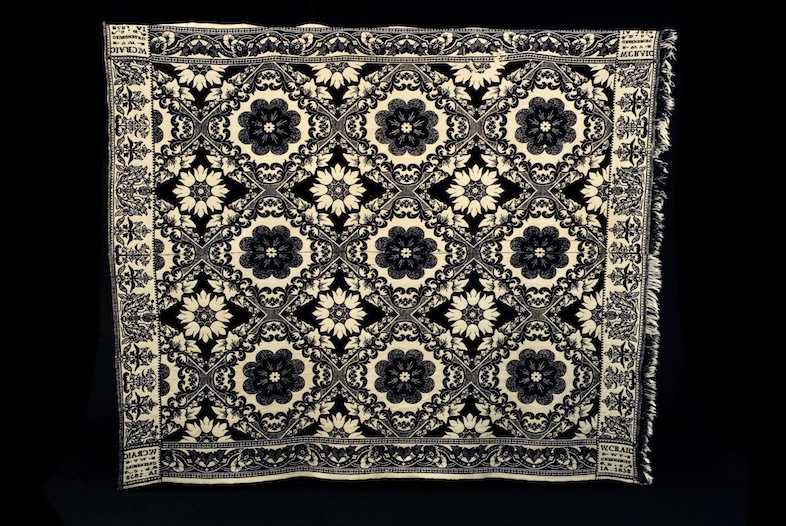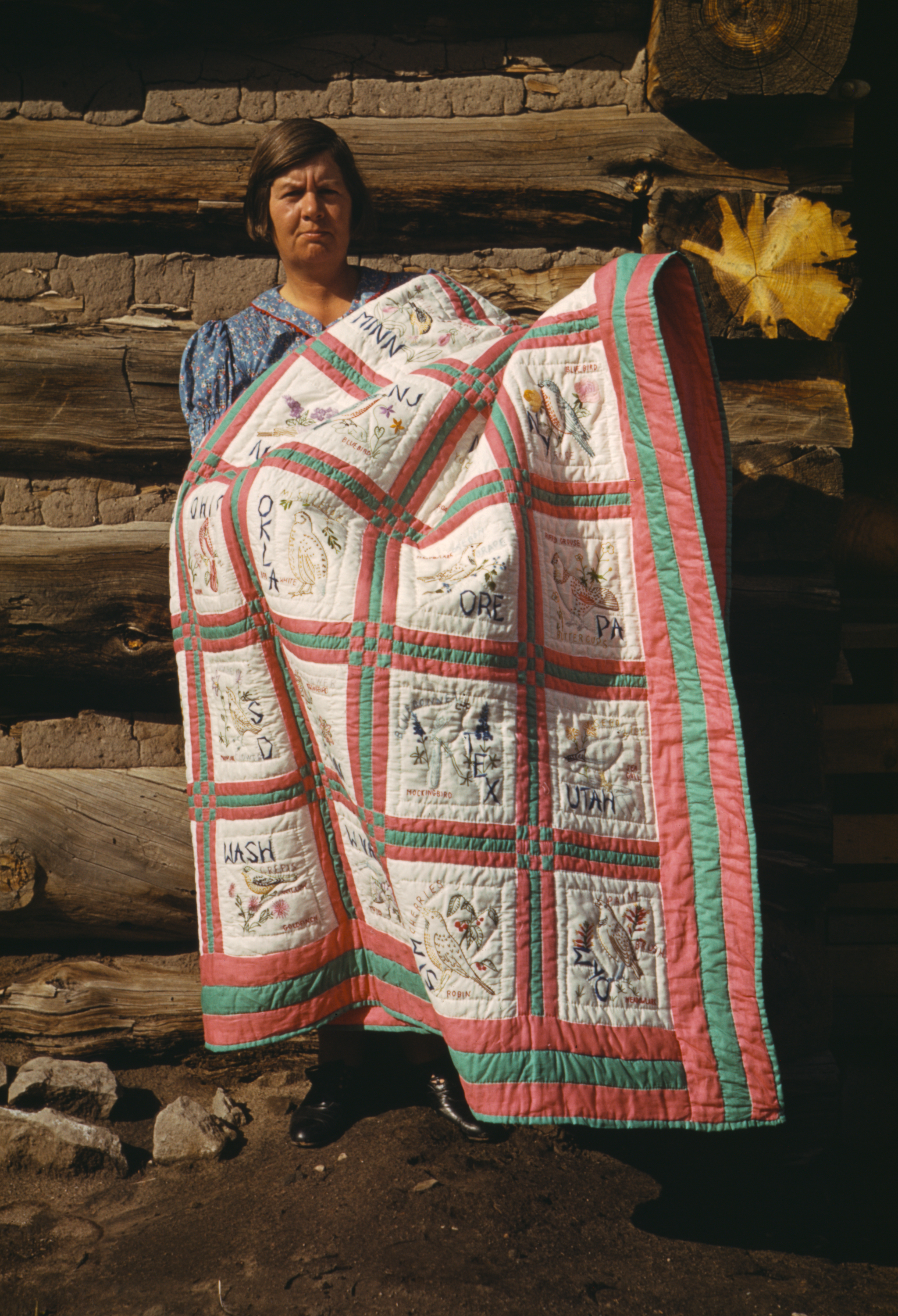|
Ticking (textile)
Ticking is a type of cloth, traditionally a tightly-woven cotton or linen textile. It is traditionally used to cover tick mattresses and bed pillows. The tight weave makes it more durable and hinders the stuffing (palliasse, straw, chaff, hair, down feathers, etc.) from poking through the fabric. To make it even tighter, ticking could be waxed, soaped, or Starch#Clothing starch, starched. Tick materials designed to hold foam may be knit, or more porous. In English-speaking countries ticking commonly has a striped design, in muted colors such as brown, grey or blue, and occasionally red or yellow, against a plain, neutral background. Although traditionally used for mattresses and pillows, the material has found other uses, such as serving as a backing for quilts, woven coverlet, coverlets, and other bedding. It is sometimes woven with a twill weave. Ticking is no longer restricted to a utility fabric and has found uses in interior decorating styles intending to evoke a homespun o ... [...More Info...] [...Related Items...] OR: [Wikipedia] [Google] [Baidu] |
Cotton
Cotton (), first recorded in ancient India, is a soft, fluffy staple fiber that grows in a boll, or protective case, around the seeds of the cotton plants of the genus '' Gossypium'' in the mallow family Malvaceae. The fiber is almost pure cellulose, and can contain minor percentages of waxes, fats, pectins, and water. Under natural conditions, the cotton bolls will increase the dispersal of the seeds. The plant is a shrub native to tropical and subtropical regions around the world, including the Americas, Africa, Egypt and India. The greatest diversity of wild cotton species is found in Mexico, followed by Australia and Africa. Cotton was independently domesticated in the Old and New Worlds. The fiber is most often spun into yarn or thread and used to make a soft, breathable, and durable textile. The use of cotton for fabric is known to date to prehistoric times; fragments of cotton fabric dated to the fifth millennium BC have been found in the Indus Valley civilizat ... [...More Info...] [...Related Items...] OR: [Wikipedia] [Google] [Baidu] |
Bedding
Bedding, also called bedclothes or bed linen, is the materials laid above the mattress of a bed for hygiene, warmth, protection of the mattress, and decorative effect. Bedding is the removable and washable portion of a human sleeping environment. Multiple sets of bedding for each bed are often washed in rotation and/or changed seasonally to improve sleep comfort at varying room temperatures. Most standardized measurements for bedding are rectangular, but there are also some square-shaped sizes, which allows the user to put on bedding without having to consider its lengthwise orientation (e.g. a duvet). In American English, the word ''bedding'' generally does not include the mattress, while in British English it often does. In Australian English, Australian and New Zealand English, bedding is often called ''manchester'', especially in shops. Manchester was a center of the cotton industry in the late 18th and the 19th century, and into the 20th century, and so cotton goods (princi ... [...More Info...] [...Related Items...] OR: [Wikipedia] [Google] [Baidu] |
Denim
Denim is a sturdy cotton warp-faced textile in which the weft passes under two or more Warp (weaving), warp threads. This twill weave produces a diagonal ribbing that distinguishes it from cotton duck. Denim, as it is recognized today, was first produced in Nîmes, France. Denim is available in a range of colors, but the most common denim is Indigo dye, indigo denim in which the Warp (weaving), warp thread is dyed while the weft thread is left white. As a result of the warp-faced twill weaving, one side of the textile is dominated by the blue warp threads, and the other side is dominated by the white weft threads. Jeans fabricated from this cloth are thus predominantly white on the inside. Denim is used to create a wide variety of garments, accessories, and furniture. Etymology ''Denim'' originated as a contraction of the French phrase ('Serge (fabric), serge from Nîmes'). History Denim has been used in the United States since the mid-19th century. Denim initially gained ... [...More Info...] [...Related Items...] OR: [Wikipedia] [Google] [Baidu] |
Settee
A couch, also known as a sofa, settee, chesterfield, or davenport, is a cushioned piece of furniture that can seat multiple people. It is commonly found in the form of a bench with upholstered armrests and is often fitted with springs and tailored cushion and pillows. Although a couch is used primarily for seating, it may be used for sleeping. In homes, couches are normally put in the family room, living room, den, or lounge. They are sometimes also found in non-residential settings such as hotels, lobbies of commercial offices, waiting rooms, and bars. Couches can also vary in size, color, and design. Etymology The term ''couch'' originally denoted an item of furniture for lying or sleeping on. ''Couch'' is predominantly used in North America, Australia, South Africa, and Ireland, whereas the terms ''sofa'' and ''settee'' (U and non-U) are most commonly used in the United Kingdom and India. The word ''couch'' originated in Middle English from the Old French noun ', whi ... [...More Info...] [...Related Items...] OR: [Wikipedia] [Google] [Baidu] |
Parka
A parka, like the related anorak, is a type of coat (clothing), coat with a hood (headgear), hood, that may be lining (sewing), lined with fur or fake fur. Parkas and anoraks are staples of Inuit clothing, traditionally made from Reindeer, caribou or pinniped, seal skin, for hunting and kayaking in the frigid Arctic. Some Inuit anoraks require regular coating with fish oil to retain their water resistance. Parkas are typically longer, often extending to the thighs or knees. Anoraks are usually shorter than parkas, often hip-length, and are traditionally a pull-over jacket. The words ''anorak'' and ''parka'' have been used interchangeably, but they are somewhat different garments. Strictly speaking, an anorak is a waterproof, hooded, pull-over jacket without a front opening, and sometimes drawstrings at the waist and cuffs, and a parka is a hip-length cold-weather coat, typically stuffed with down feather, down or very warm synthetic fiber, and with a fur-lined hood. Etymology T ... [...More Info...] [...Related Items...] OR: [Wikipedia] [Google] [Baidu] |
USDA
The United States Department of Agriculture (USDA) is an United States federal executive departments, executive department of the Federal government of the United States, United States federal government that aims to meet the needs of commercial farming and livestock food production, promotes agricultural trade and production, works to assure food safety, protects natural resources, fosters rural communities and works to end hunger in the United States and internationally. It is headed by the secretary of agriculture, who reports directly to the president of the United States and is a member of the president's Cabinet of the United States, Cabinet. The current secretary is Brooke Rollins, who has served since February 13, 2025. Approximately 71% of the USDA's $213 billion budget goes towards nutrition assistance programs administered by the Food and Nutrition Service (FNS). The largest component of the FNS budget is the Supplemental Nutrition Assistance Program (formerly ... [...More Info...] [...Related Items...] OR: [Wikipedia] [Google] [Baidu] |
Percale
Percale is a closely woven plain-weave fabric often used for bed covers. Percale has a thread count of about 180 or higher and is noticeably tighter than twill or sateen. It has medium weight, is firm and smooth with no gloss, and washes very well. It is made from both carded and combed yarns, and may be woven of various fibers, such as cotton, polyester, or various blends. History ''Moris'' or ''mauris'' was the 18th-century French term used for percale, the cloth imported from India. It was a cotton cloth. Moris was the third most exported fabric from Coromandel Coast after Longcloth and Salampore. It was superior and finer quality than the peers. Coromandel coastline forms a part of Tamil Nadu and Andhra Pradesh. Moris was produced at Nellore, Arni, Maduranthakam, and Cuddalore. Palakollu. The cloth was famous as painted chintz in southeast countries also. Percale was formerly imported from India in the 17th and 18th centuries, then manufactured in France. Etymo ... [...More Info...] [...Related Items...] OR: [Wikipedia] [Google] [Baidu] |
Twill
Twill is a type of textile Textile is an Hyponymy and hypernymy, umbrella term that includes various Fiber, fiber-based materials, including fibers, yarns, Staple (textiles)#Filament fiber, filaments, Thread (yarn), threads, and different types of #Fabric, fabric. ... weave with a pattern of parallel, diagonal ribs. It is one of three fundamental types of weave, along with plain weave and satin. It is made by passing the weft thread over one or more warp threads then under two or more warp threads and so on, with a "step", or offset, between rows to create the characteristic diagonal pattern. Due to this structure, twill generally drapes well. Classification Twill weaves can be classified from four points of view: # According to the stepping: #* ''Warp-way'': 3/1 warp way twill, etc. #* ''Weft-way'': 2/3 weft way twill, etc. # According to the direction of twill lines on the face of the fabric: #* ''S-twill'', or ''left-hand twill weave'': 2/1 S, etc. #* ' ... [...More Info...] [...Related Items...] OR: [Wikipedia] [Google] [Baidu] |
Woven Coverlet
A woven coverlet or coverlid (derived from Catalan language, Cat. ''cobrellit'') is a type of bed covering with a weaving, woven design in colored wool yarn on a background of natural linen or cotton. Coverlets were woven in almost every community in the United States from the Colonial America, colonial era until the late 19th century.Weissman, Judith Reiter and Wendy Lavitt: ''Labors of Love: America's Textiles and Needlwork, 1650-1930'', New York, Wings Books, 1987, , p. 80-97 History Coverlets of 18th century America were twill-woven with a linen warp (weaving), warp and woolen weft. The wool was most often dyed a dark blue from indigo dye, indigo, but Rose madder, madder red, walnut brown, and a lighter "Williamsburg, Virginia, Williamsburg blue" were also used. From the turn of the 19th century, simple twill-woven coverlets gave way to patterned hand-woven coverlets made in two different ways: *Overshot weave coverlets were made with a plain weave, plain woven undyed cott ... [...More Info...] [...Related Items...] OR: [Wikipedia] [Google] [Baidu] |
Linen
Linen () is a textile made from the fibers of the flax plant. Linen is very strong and absorbent, and it dries faster than cotton. Because of these properties, linen is comfortable to wear in hot weather and is valued for use in garments. Linen textiles can be made from flax plant fiber, yarn, as well as woven and knitted. Linen also has other distinctive characteristics, such as its tendency to wrinkle. It takes significantly longer to harvest than a material like cotton, although both are natural fibers. It is also more difficult to weave than cotton. Linen textiles appear to be some of the oldest in the world; their history goes back many thousands of years. Dyed flax fibers found in a cave in the Caucasus (present-day Georgia (country), Georgia) suggest the use of woven linen fabrics from wild flax may date back over 30,000 years. Linen was used in ancient civilizations including Mesopotamia and ancient Egypt, and linen is mentioned in the Bible. In the 18th century and be ... [...More Info...] [...Related Items...] OR: [Wikipedia] [Google] [Baidu] |
Quilt
A quilt is a multi-layered textile, traditionally composed of two or more layers of fabric or fiber. Commonly three layers are used with a filler material. These layers traditionally include a woven cloth top, a layer of padding, batting or wadding, and a woven back combined using the techniques of quilting. This is the process of sewing on the face of the fabric, and not just the edges, to combine the three layers together to reinforce the material. Stitching patterns can be a decorative element. A single piece of fabric can be used for the top of a quilt (a "whole-cloth quilt"), but in many cases the top is created from smaller fabric pieces joined, or patchwork. The pattern and color of these pieces creates the design. Quilts may contain valuable historical information about their creators, "visualizing particular segments of history in tangible, textured ways". In the twenty-first century, quilts are frequently displayed as non-utilitarian works of art but historically qui ... [...More Info...] [...Related Items...] OR: [Wikipedia] [Google] [Baidu] |








